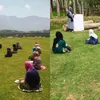It takes more than just a village to raise a child now, it takes the whole country
The pandemic has had a profound effect on children from less privileged background by depriving them access to basic education and exposing them to the vagaries of an uncertain future.
In the past three years, Ayesha’s (name changed) mother has never seen her so unhappy. She sulks all day and hardly talks to anyone. Her father simply dismisses it as ‘teenage blues’, but her mother senses otherwise. She knows Ayesha is missing her school. Not just her friends, or her teachers, Ayesha misses the school itself – the environment that it brings.
Three years ago, when a local NGO prevented her from getting married off and put her back in school, the 12-year-old had realised that education meant not only about passing exams but also about clinging to her dreams. And she had held on to that hope, giving everything to it.
With COVID-19 bringing all of India to a halt for months, Ayesha’s life was confined to their one-room house in a slum, wondering if this was the chance her father was waiting for, to get her to leave school again, and get ‘the burden off his shoulders’. How would the little girl bring herself to smile?
Ayesha’s story, however, is not Ayesha’s alone.
With the global pandemic bringing the sharp divide between the haves and the have-nots into the limelight yet again, marginalised children are on top of the list of the multitudes missing out on their access to education due to lack of online access.
And what does missing out on the access to education mean? For some, it means unending holidays and loads of free time for sure; but for some others, it does mean that the door towards exploitation is ajar. To simplify, as the situation created by the pandemic has badly hurt children’s education, they are now more vulnerable than ever, affected by the domino effects created by the financial instability of the poor.
With an economic crisis looming large, comes far-reaching effects, especially on children – terrifying indeed, as the effects largely stay invisible until they are all upon them.
Sunil’s (name changed) father lost his job due to the pandemic and her mother, a house-help, has been barred to enter to the residential complex she used to work in. Sunil is 14 years old, a student of the ninth standard.
He spends the day helping his mother in the household work while trying to convince himself hard that it is alright if he can’t go back to school when all this is over. Can his parents really afford it anymore? – the boy asks himself as he comes to terms with the raw deal, handed to him by the circumstances.
The lesser the job prospects, the more the trenches – the bigger the financial crisis in the families that barely survive on basics. This is simple math. The complexity lies in the excesses that will be curtailed. Sadly, for families living at the brink of losing their all, education becomes one of these excesses, especially with a trend to shift to methods of e-learning to maintain social distancing norms.
In our forty years of working with children’s rights at CRY – Child Rights and You, I have never seen a health hazard creating such a huge impact on children, though indirectly.
The reality is staring at our faces now. The huge financial losses will stop many parents from sending their children to school. The limited resources the parents can manage generally will barely go in ensuring a day’s meal for the family. Between survival and development, can they be blamed for choosing the former?
Let me give you some numbers as food for thought. There are 10.13 million child laborers between 5-14 years in India (2011 Census data). Although the growth rate of working children in urban areas witnessed a worrying leap between the period 2001-2011 (53%) compared to the rural regions (which saw a decrease by 29% over the decade), a substantial portion (80%) of working children in India continue to be from the rural areas.
This trend is soon going to change with reverse migration taking place within the marginalised community. Are our village education systems equipped to handle this added pressure?
The closer they are to adolescence, the more vulnerable children become, in terms of dropping out of schools. For example, around 70 per cent of children of 8 years old attend school, while only 33 per cent of children aged 14 do so.
The percentage further diminishes to 17.8 per cent as on when they reach 17 years. And this is common sense, that a child out of school is always times more likely to be exploited than one in school.
But how does it help if we don’t start looking at solutions? We must ensure that children’s education is not hampered. If there is no way out, our focus must be turned towards ensuring that they are closely monitored so they aren’t dragged into illegal practices and unsafe situations.
It does take a village to raise a child. Safeguarding a child’s interest cannot happen in seclusion. We need to protect the ecosystem to ensure their well-being. The pandemic has challenged precisely that process.
Living just to survive, parents have to depend on National Rural Employment Guarantee Schemes. If the employment guarantee scheme under the NREGA can be extended to around 200 or more days a year from just a 100, it would work in favour of protecting the ecosystem of a child, a critical prerequisite for taking proactive measures.
And while we keep asking for better schemes and effective governance, we cannot ignore our roles today. The responsibility, more than ever, lies with us, the civil society.
We must collaborate, ideate and innovate to support the State’s endeavours and create our own mechanisms to ensure that children do not miss out on what is essentially their right to a bright future.
There is no limit to the opportunities that access to education creates, and now, more than ever, I can hear Rippan Kapur (the late founder of CRY) say, “If we all do something, then together there is no problem that we cannot solve.”
(Disclaimer: The views and opinions expressed in this article are those of the author and do not necessarily reflect the views of YourStory.)








